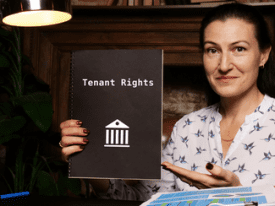Buying a House With Tenants: A Quick Guide
Whether you are interested in buying a home to use as a primary residence or an investment property, it’s possible that the property is currently occupied by tenants. If that’s the case, there are a few things you should consider before deciding to go through with the purchase. Read on for a quick introduction to tenant rights, landlord obligations and how to limit risks when buying a house with tenants in place.
Tenant Rights

If you definitely want the tenants to move out, you have a couple of options. One is to submit an offer on the house that is contingent on the home being vacant (that is, no tenants) when you close. This puts the burden on the seller to either break the lease or offers an incentive to the tenants to leave early. If the seller is unable (or unwilling) to do this, you can walk away and start looking for another house. The other option is to buy the property and then break the lease(s), renegotiate the terms or “buy out” the tenant(s) yourself. But in this scenario, keep in mind that a tenant is under no obligation to accept any new terms if they have a valid lease in place—and you could open yourself up to a lawsuit if you break the lease or try to force an eviction.
Landlord Obligations
As the new owner, you inherit the landlord obligations. A big part of being a landlord is maintaining a safe and habitable property for your tenants. In general, you must (at a minimum):
- Keep all common areas, such as hallways and stairways, in a safe and clean condition.
- Make sure structural elements are safe and intact (floors, walls, stairs, elevators, roofs).
- Ensure that electrical, plumbing, heating/air conditioning (HVAC), ventilation and sanitary systems are properly maintained.
- Make sure tenants have access to running water, hot water and heat in reasonable amounts at reasonable times.
- Provide trash containers and arrange for trash removal.
- Manage known environmental toxins including lead paint dust and asbestos.
- Exterminate rodents and other vermin infestations.
Your local laws may call for additional requirements regarding habitability—review them to make sure you are in compliance. Also, it’s vital that you read the lease to find out any other specific obligations you may have—such as mowing the lawn or paying for utilities.
Changing or Terminating a Lease
In general, if the tenant has a month-to-month lease, you (as the new landlord) can terminate the tenancy or increase the rent before the start of a new month, provided you give the appropriate notice (typically 30 days, but this varies by state and by the number of months the tenant has occupied the property). If a fixed-term lease is in place (e.g., six months or 12 months) however, the tenant has a legal right (in most cases) to occupy the home for as long as the lease is active, regardless of who owns the home.

Finally, if you plan on using the home as your primary residence (and not as a rental property), you may be able to use an owner move-in eviction (OMI) to get a tenant to move out. Rules for this vary by state, but in general, you must move into the home within a prescribed number of days of the eviction (often 60 to 90 days) and live in it as your primary residence for a minimum number of years (often one to five).
The Bottom Line
An important first step is to review lease documents before you close so you know what you’re getting into and so you can ensure that the lease is well-written and structured to follow local rental laws. If anything seems off, demand that the seller fix the language as a condition of your closing. It’s also important to get not only the records for any prepaid rent and security deposits but also the money (it should be transferred to you on the closing statement). You’ll probably have to keep the security deposit in a trust account (depending on your state) and the closing agent should pro-rate the current rent payment between you and the seller.
Also, be sure the seller provides documentation regarding the condition of the property before the tenant moved in—if there’s damage, you’ll have a hard time proving the tenant is responsible without a check-in report. If possible, meet with the tenants prior to closing so you can verify the current condition of the home and discuss the lease terms.
Finally, make sure you are appropriately insured. A standard homeowner policy typically won’t do the job. Inform your insurer that the home is being rented so that you’ll be covered in case of tenant injuries, negligence, and other losses.
Source: Investopedia















 Accessibility
Accessibility